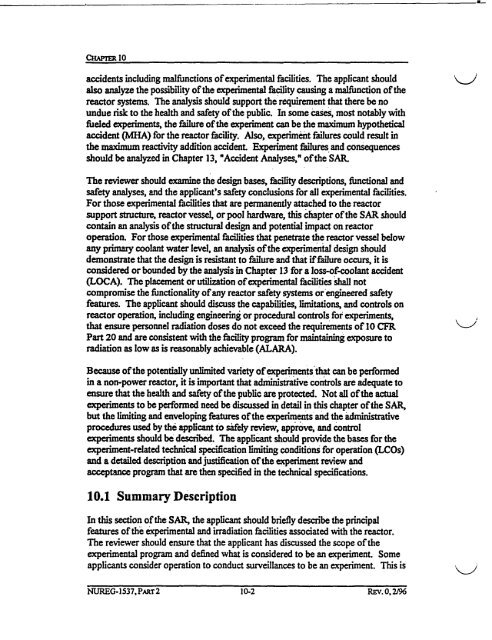NUREG-1537, Part 2 - NRC
NUREG-1537, Part 2 - NRC
NUREG-1537, Part 2 - NRC
Create successful ePaper yourself
Turn your PDF publications into a flip-book with our unique Google optimized e-Paper software.
CHAPTER 10<br />
accidents including malfunctions of experimental facilities. The applicant should<br />
also analyze the possibility of the expeimental facility causing a malfunction of the<br />
reactor systems. The analysis should support the requirement that there be no<br />
undue risk to the health and safety of the public. In some cases, most notably with<br />
fueled experiments, the failure of the experiment can be the maximum hypothetical<br />
accident (MHA) for the reactor facility. Also, experiment failures could result in<br />
the maximum reactivity addition accident Experiment failures and consequences<br />
should be analyzed in Chapter 13, 'Accident Analyses," of the SAR.<br />
The reviewer should examine the design bases, facility descriptions, functional and<br />
safety analyses, and the applicant's safety conclusions for all experimental facilities.<br />
For those experimental facilities that are permanently attached to the reactor<br />
support structure, reactor vessel, or pool hardware, this chapter of the SAR should<br />
contain an analysis of the structural design and potential impact on reactor<br />
operation. For those experimental facilities that penetrate the reactor vessel below<br />
any primary coolant water level, an analysis of the experimental design should<br />
demonstrate that the design is resistant to failure and that if failure occurs, it is<br />
considered or bounded by the analysis in Chapter 13 for a loss-of-coolant accident<br />
(LOCA). The placement or utilization of experimental facilities shall not<br />
compromise the functionality of any reactor safety systems or engineered safety<br />
features. The applicant should discuss the capabilities, limitations, and controls on<br />
reactor operation, including engineering or procedural controls for experiments,<br />
that ensure personnel radiation doses do not exceed the requirements of 10 CFR<br />
<strong>Part</strong> 20 and are consistent with the facility program for maintaining exposure to<br />
radiation as low as is reasonably achievable (ALARA).<br />
Because of the potentially unlimited variety of experiments that can be performed<br />
in a non-power reactor, it is important that administrative controls are adequate to<br />
ensure that the health and safety of the public are protected. Not all of the actual<br />
experiments to be performed need be discussed in detail in this chapter of the SAR,<br />
but the limiting and enveloping features of the experiments and the administrative<br />
procedures used by the applicant to safely review, approve, and control<br />
experiments should be described. The applicant should provide the bases for the<br />
experiment-related technical specification limiting conditions for operation (LCOs)<br />
and a detailed description and justification of the experment review and<br />
acceptance program that are then specified in the technical specifications.<br />
10.1 Summary Description<br />
In this section of the SAR, the applicant should briefly describe the principal<br />
features of the experimental and irradiation facilities associated with the reactor.<br />
The reviewer should ensure that the applicant has discussed the scope of the<br />
experimental program and defined what is considered to be an experiment. Some<br />
applicants consider operation to conduct surveillances to be an experiment. This is J<br />
NURBG-<strong>1537</strong>,PART2 10-2 REV. 0,2/96<br />
<strong>NUREG</strong>-<strong>1537</strong>,PART2 10-2 REV. 0, 2196
















